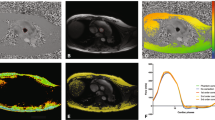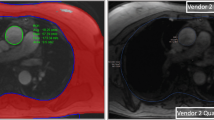Abstract
Background
The need for background error correction in phase-contrast flow analysis has historically posed a challenge in cardiac magnetic resonance (MR) imaging. While previous studies have shown that phantom correction improves flow measurements, it impedes scanner workflow.
Objective
To evaluate the efficacy of self-calibrated non-linear phase-contrast correction on flows in pediatric and congenital cardiac MR compared to phantom correction as the standard.
Materials and methods
We retrospectively identified children who had great-vessel phase-contrast and static phantom sequences acquired between January 2015 and June 2015. We applied a novel correction method to each phase-contrast sequence post hoc. Uncorrected, non-linear, and phantom-corrected flows were compared using intraclass correlation. We used paired t-tests to compare how closely non-linear and uncorrected flows approximated phantom-corrected flows. In children without intra- or extracardiac shunts or significant semilunar valvular regurgitation, we used paired t-tests to compare how closely the uncorrected pulmonary-to-systemic flow ratio (Qp:Qs) and non-linear Qp:Qs approximated phantom-corrected Qp:Qs.
Results
We included 211 diagnostic-quality phase-contrast sequences (93 aorta, 74 main pulmonary artery [MPA], 21 left pulmonary artery [LPA], 23 right pulmonary artery [RPA]) from 108 children (median age 15 years, interquartile range 11–18 years). Intraclass correlation showed strong agreement between non-linear and phantom-corrected flow measurements but also between uncorrected and phantom-corrected flow measurements. Non-linear flow measurements did not more closely approximate phantom-corrected measurements than did uncorrected measurements for any vessel. In 39 children without significant shunting or regurgitation, mean non-linear Qp:Qs (1.07; 95% confidence interval [CI] = 1.01, 1.13) was no closer than mean uncorrected Qp:Qs (1.06; 95% CI = 1.00, 1.13) to mean phantom-corrected Qp:Qs (1.02; 95% CI = 0.98, 1.06).
Conclusion
Despite strong agreement between self-calibrated non-linear and phantom correction, cardiac flows and shunt calculations with non-linear correction were no closer to phantom-corrected measurements than those without background correction. However, phantom-corrected flows also demonstrated minimal differences from uncorrected flows. These findings suggest that in the current era, more accurate phase-contrast flow measurements might limit the need for background correction. Further investigation of the clinical impact and optimal methods of background correction in the pediatric and congenital cardiac population is needed.




Similar content being viewed by others
References
Bernstein MA, Zhou XJ, Polzin JA et al (1998) Concomitant gradient terms in phase contrast MR: analysis and correction. Magn Reson Med 39:300–308
Markl M, Bammer R, Alley MT et al (2003) Generalized reconstruction of phase contrast MRI: analysis and correction of the effect of gradient field distortions. Magn Reson Med 50:791–801
Gatehouse PD, Rolf MP, Graves MJ et al (2010) Flow measurement by cardiovascular magnetic resonance: a multi-centre multi-vendor study of background phase offset errors that can compromise the accuracy of derived regurgitant or shunt flow measurements. J Cardiovasc Magn Reson 12:5
Chernobelsky A, Shubayev O, Comeau CR, Wolff SD (2007) Baseline correction of phase contrast images improves quantification of blood flow in the great vessels. J Cardiovasc Magn Reson 9:681–685
Miller TA, Landes AB, Moran AM (2009) Improved accuracy in flow mapping of congenital heart disease using stationary phantom technique. J Cardiovasc Magn Reson 11:52
Holland BJ, Printz BF, Lai WW (2010) Baseline correction of phase-contrast images in congenital cardiovascular magnetic resonance. J Cardiovasc Magn Reson 12:1
Pelc NJ, Herfkens RJ, Shimakawa A, Enzmann DR (1991) Phase contrast cine magnetic resonance imaging. Magn Reson Q 7:229–254
Walker PG, Cranney GB, Scheidegger MB et al (1993) Semiautomated method for noise reduction and background phase error correction in MR phase velocity data. J Magn Reson Imaging 3:521–530
Lankhaar J-W, Hofman MBM, Marcus JT et al (2005) Correction of phase offset errors in main pulmonary artery flow quantification. J Magn Reson Imaging 22:73–79
Rigsby CK, Hilpipre N, McNeal GR et al (2014) Analysis of an automated background correction method for cardiovascular MR phase contrast imaging in children and young adults. Pediatr Radiol 44:265–273
Giese D, Haeberlin M, Barmet C et al (2012) Analysis and correction of background velocity offsets in phase-contrast flow measurements using magnetic field monitoring. Magn Reson Med 67:1294–1302
Tan ET, Brau AC, Hardy CJ (2014) Nonlinear self-calibrated phase-contrast correction in quantitative cardiac imaging. J Cardiovasc Magn Reson 16:P349
Kilner PJ, Gatehouse PD, Firmin DN (2007) Flow measurement by magnetic resonance: a unique asset worth optimising. J Cardiovasc Magn Reson 9:723–728
Nayak KS, Nielsen J-F, Bernstein MA et al (2015) Cardiovascular magnetic resonance phase contrast imaging. J Cardiovasc Magn Reson 17:71
Rolf MP, Hofman MB, Gatehouse PD et al (2011) Sequence optimization to reduce velocity offsets in cardiovascular magnetic resonance volume flow quantification — a multi-vendor study. J Cardiovasc Magn Reson 13:18
Meierhofer C, Lyko C, Schneider EP et al (2015) Baseline correction does not improve flow quantification in phase-contrast velocity measurement for routine clinical practice. Clin Imaging 39:427–431
Busch J, Giese D, Kozerke S (2017) Image-based background phase error correction in 4D flow MRI revisited. J Magn Reson Imaging 46:1516–1525
Acknowledgments
We would like to acknowledge Dr. Codruta Chiuzan for her input and guidance on our statistical analysis. This research was supported by a gift from Colin’s Kids Inc.
Author information
Authors and Affiliations
Corresponding author
Ethics declarations
Conflicts of interest
None
Additional information
Publisher’s note
Springer Nature remains neutral with regard to jurisdictional claims in published maps and institutional affiliations.
Rights and permissions
About this article
Cite this article
Paul, E.A., Solana, A.B., Duong, J. et al. Evaluation of self-calibrated non-linear phase-contrast correction in pediatric and congenital cardiovascular magnetic resonance imaging. Pediatr Radiol 50, 656–663 (2020). https://doi.org/10.1007/s00247-020-04623-2
Received:
Revised:
Accepted:
Published:
Issue Date:
DOI: https://doi.org/10.1007/s00247-020-04623-2




